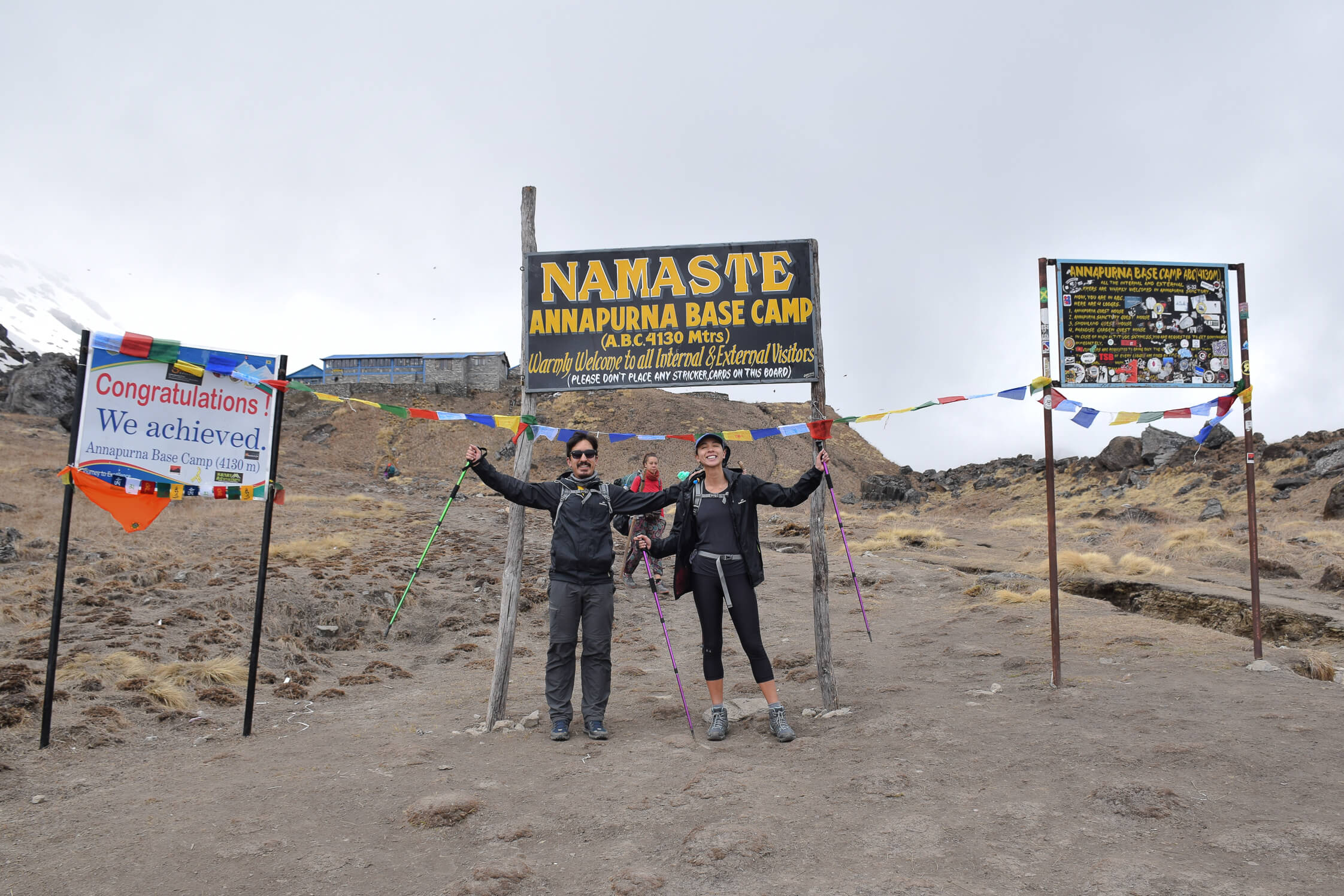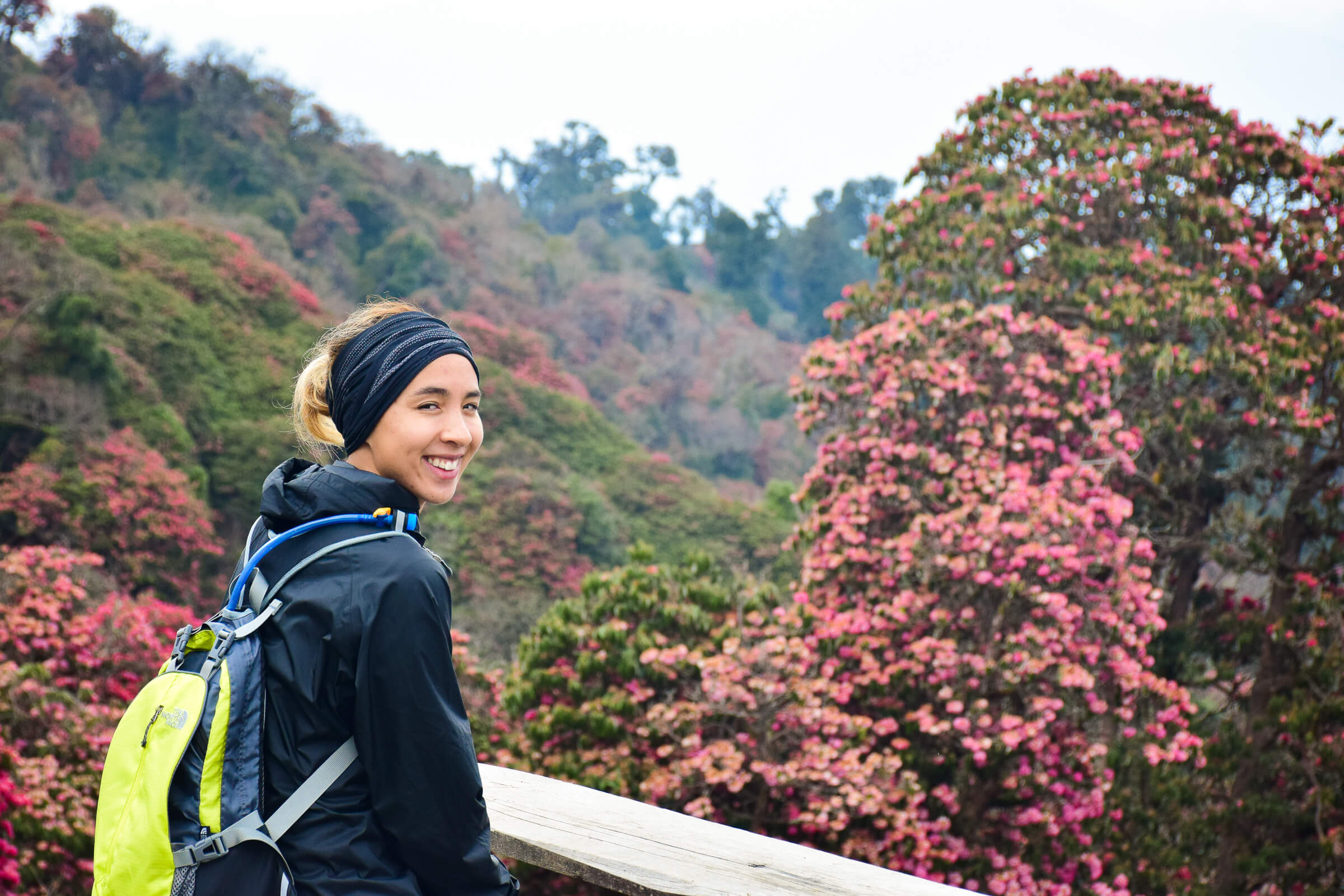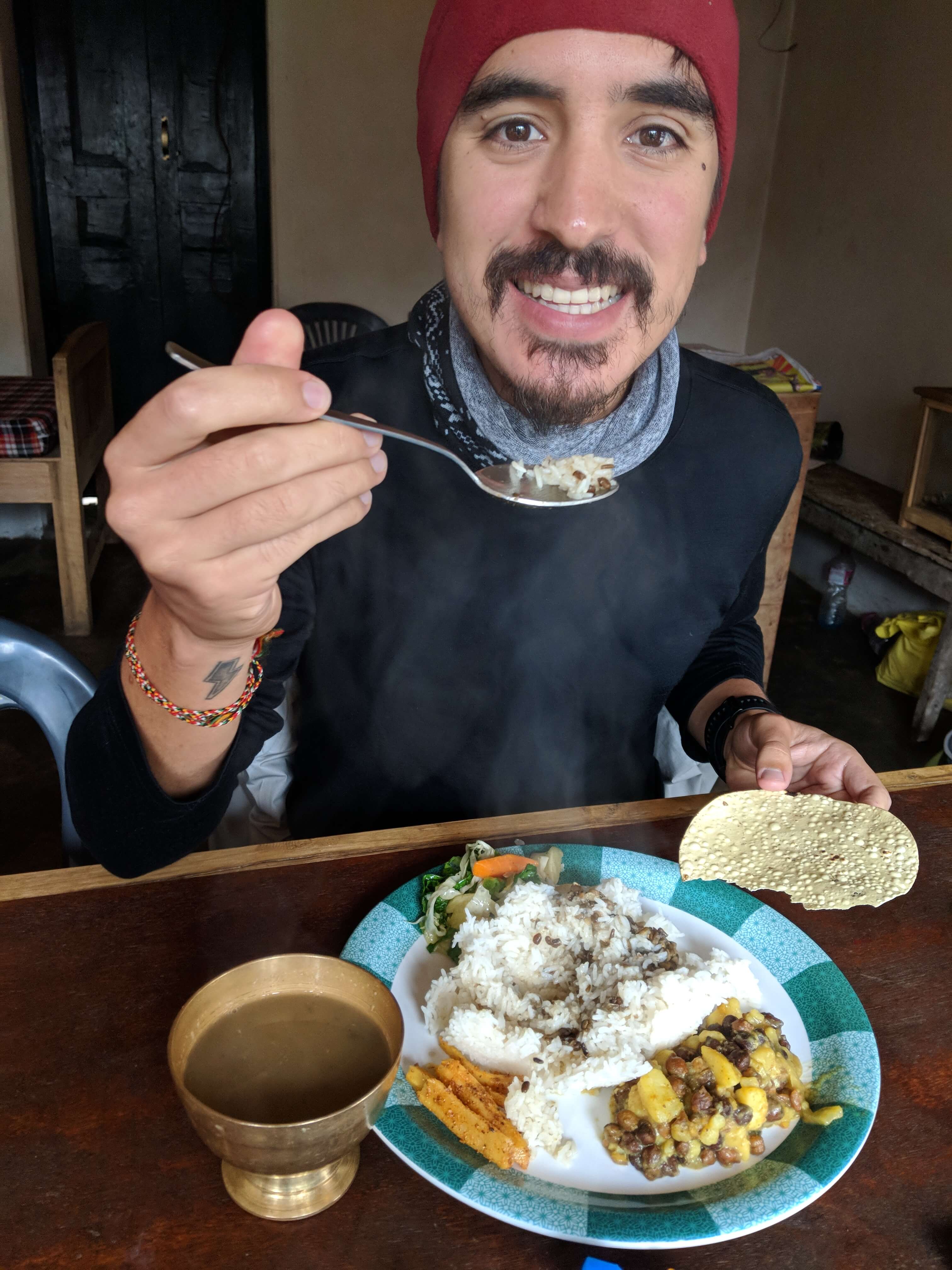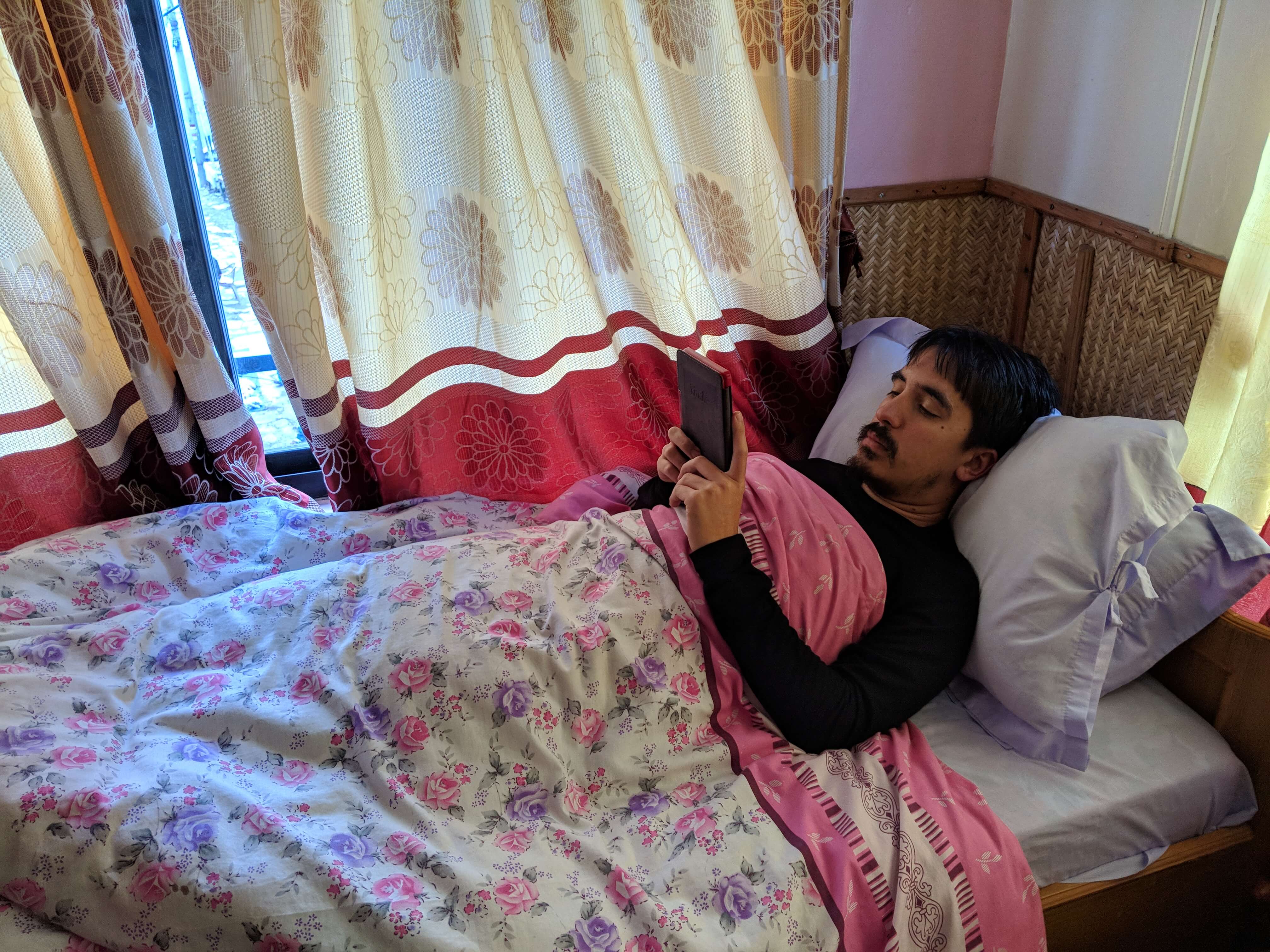Annapurna Base Camp Trek - Nepal
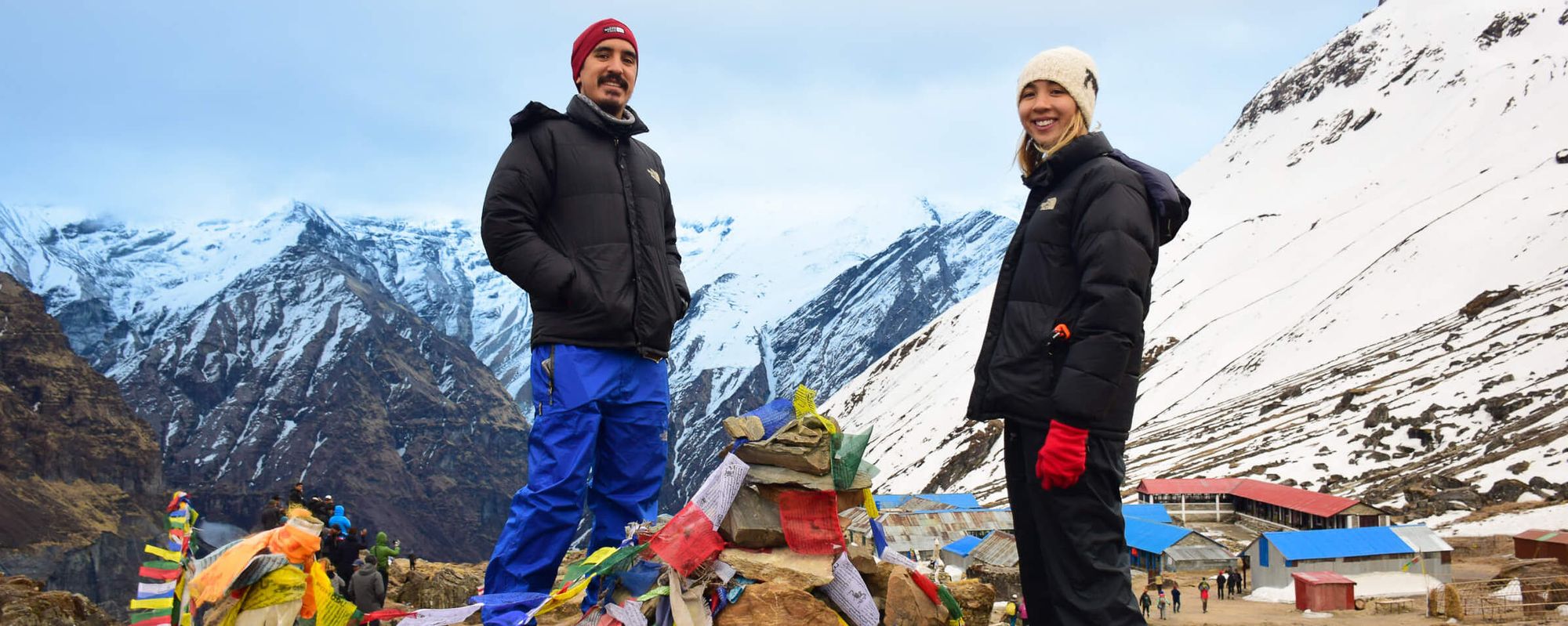
Flickr Album:

ABC Trek, by Alex

Alex getting ready for the day
When Fernando and I signed up to the Annapurna Base Camp (ABC) trek back in June last year, we did so without knowing very much - only with the promise of a scenic trail, with villages lining the way (as opposed to the less scenic and more difficult Everest Base Camp trek). Looking back, it has to be one of the best decisions we have made so far, these last 9 days have had some of the most challenging times I have ever experienced but also some of the most rewarding and satisfying.
We decided to ABC with a guide and porter (to be honest, we thought this was the way everyone did it, it turns out a lot of people -usually younger - do it on their own). Nevertheless, it was ideal for both of us, having a porter meant we only needed to carry a day pack with water & essentials and having a guide meant he could call ahead and book a room at the upcoming lodge and guide us along the way. This left us to just enjoy the day ahead and the challenge of the Himalayas. Side note - we looked into a lot of Australian/American tour companies but ended up using a local company at the recommendation of a friend, this turned out to be significantly cheaper (even just being me and Fernando, not in a group) and it meant our money was going straight to Nepal.
As far as hikes go, ABC had pretty much everything I could have hoped for; full on (but relatively short) days of hiking, incredible views along the way, and a lodge waiting for you at the end of each day, equipped with a warm dining hall, delicious food and a comfortable bed (we had our own room every night except for at ABC, where we shared with two others).This was a far cry from my camp days at Redlands - no big backpack, no stale mountain bread and no need to set up a tent at the end of each day (!)
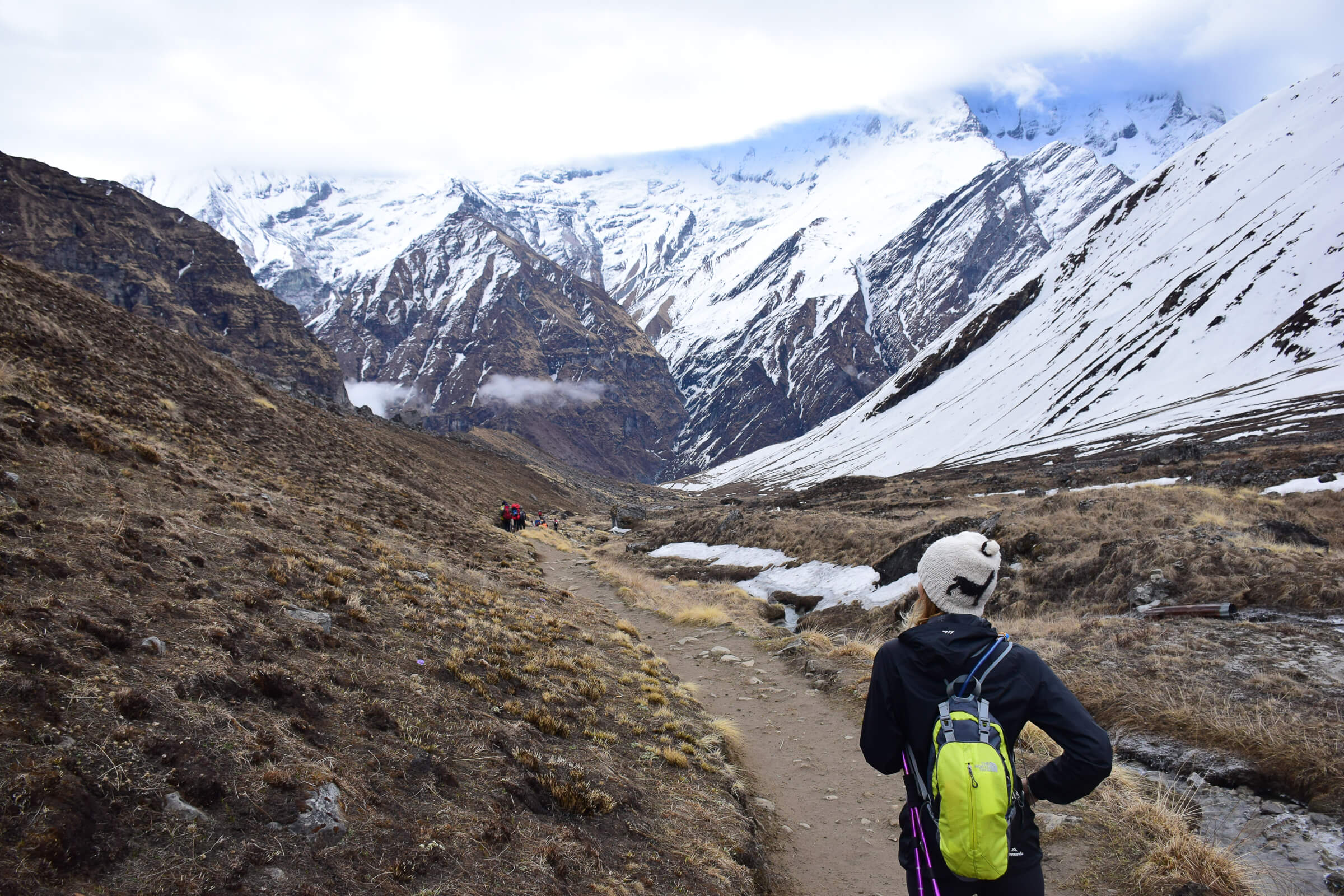
Making our way back from Base Camp
In terms of the physicality of the hike, I’d say it is a great route that can be suited to a range of people. We saw hikers of all ages (from 2-90) making their way up to ABC. Because there are so many lodges along the way, you can stay where it suits and adjust the length of your daily hike accordingly and ofcourse take your time with as many rest stops as needed. For us, we moved significantly faster than the average hiker, mainly because we weren’t carrying our own packs but also because Fernando and I enjoyed the challenge. Moving fast meant we could push ourselves physically and mentally, knowing we’d be met with a long afternoon of rest and recovery each day. This is what I enjoyed most about our ABC trek; having done long distance running for a while now, I really enjoy the challenge that comes with pushing your body to your limits (quickly tested on our first day when we had 3000 steps to walk up in the pouring rain) and then the rest and relaxation that follows. I can’t describe how good that mug of hot masala chai tasted after hiking for hours in the freezing rain, there is nothing that can compare.
The best part is that although it is a great feeling of accomplishment to reach that 4,130m peak at ABC, this wasn’t a standout of the 9 days. Every day was full of amazing experiences - the clouds would part and we’d be blessed with clear views of the mountains, or we’d pass a tree full of gorgeous rhododendrons (the local flower that only blooms this time of year) or we’d be relaxing after a day of hiking and happen across a German bakery with amazing baked goods. There was no “peak”, so to speak, we just enjoyed each day and each moment as it came to us.
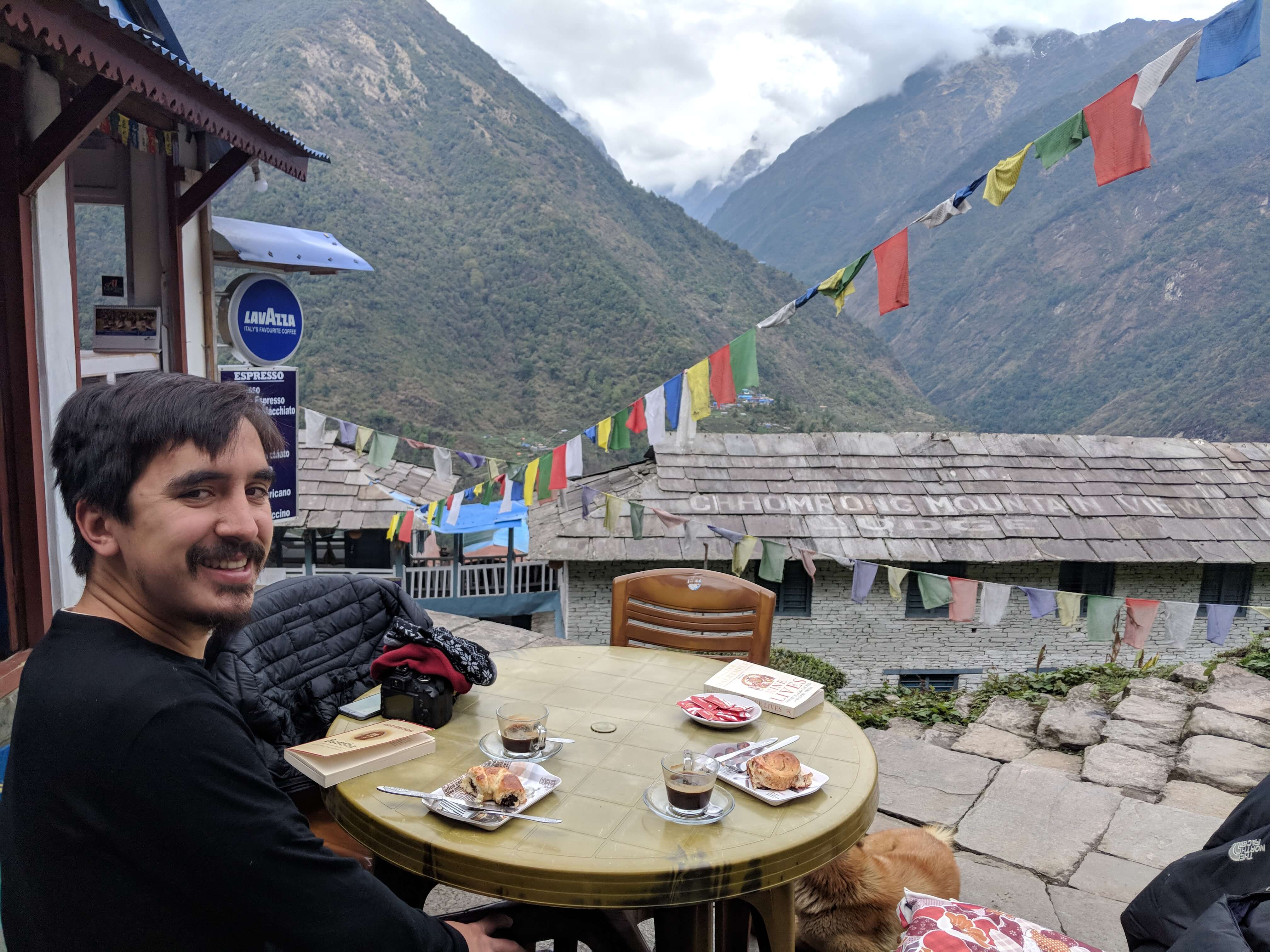
Enjoying coffee and cake at a German Bakery
Overall, ABC exceeded my expectations; to be fair I didn’t have a great picture of what to expect (e.g. I wasn’t expecting hot showers or restaurant quality food the entire way). It was pretty much as luxurious as a full on hike can be, I don’t know if there is anywhere else in the world can compare - if there is, please tell me, I’d love to go there. ABC has piqued my interest in hiking and has subsequently led me to decide to hold onto my hiking boots for the remainder of our year, so that we can do more treks. I couldn’t recommend this trek enough, there are lots of different variations one can do, not all going up to ABC, of varying lengths, so if you are interested you should definitely look into it. You will not be disappointed. I am already in talks with Fernando about coming back to do a longer trail.

ABC Trek, por Fernando
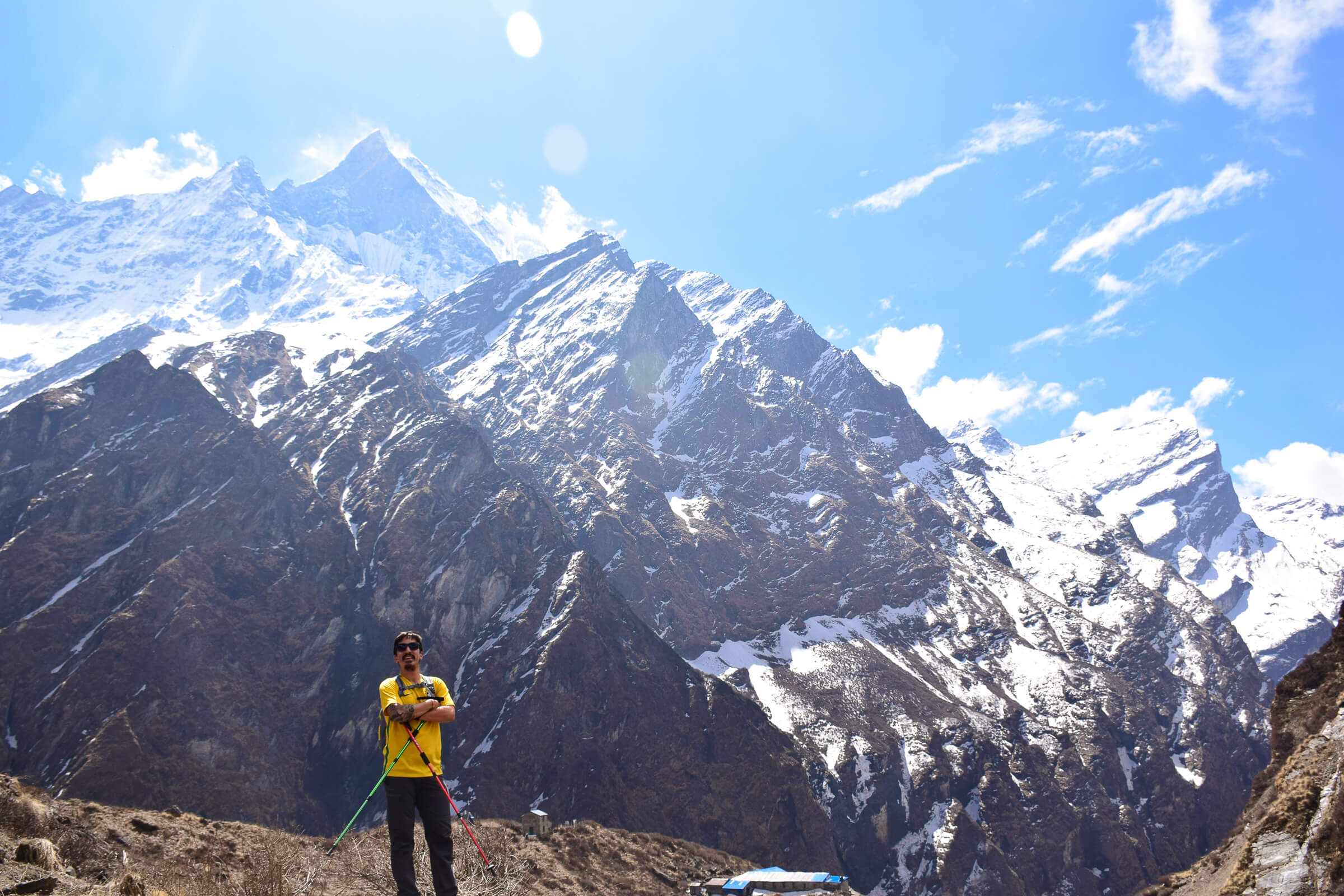
Fernando no Macchapuchhre Base Camp
Quando eu e a Alex pegamos o taxi em Pokhara para começarmos nossa caminhada de em direção ao Annapurna Base Camp, nós tínhamos pouca ideia do que estava por vir. Será que trouxemos comida o suficiente? Roupa de frio? Será que teremos banho quente no caminho? Mercadinhos para comprar comida se precisarmos? Isso foi bom, porque não criamos muita expectativa para o que estava por vir e tentamos manter nossas mentes abertas.
Annapurna é a segunda região mais famosa dos Himalaias - apenas atrás do Mt Everest - e a caminhada que fizermos nos levaria até o Base Camp, a 4130m de altitude, e de onde os alpinistas profissionais se aclimatizam e se preparam para subir algumas das várias montanhas da região - Annapurna I (8091m), Annapurna II (7937m), Annapurna III (7555m), Annapurna South (7219m), ou Hiunchuli (6441m). Lá também fica a montanha Macchapuchhre (6993m, também conhecida por “Fish Tail”, pelo formato que lembra uma cauda de peixe), que é uma montanha sagrada para os locais, então o governo do Nepal não autoriza ninguém a escalar essa e até hoje ninguém nunca subiu ao topo.
Apenas 14 montanhas do mundo tem mais de 8000m de altitude, e 8 delas estão no Nepal.
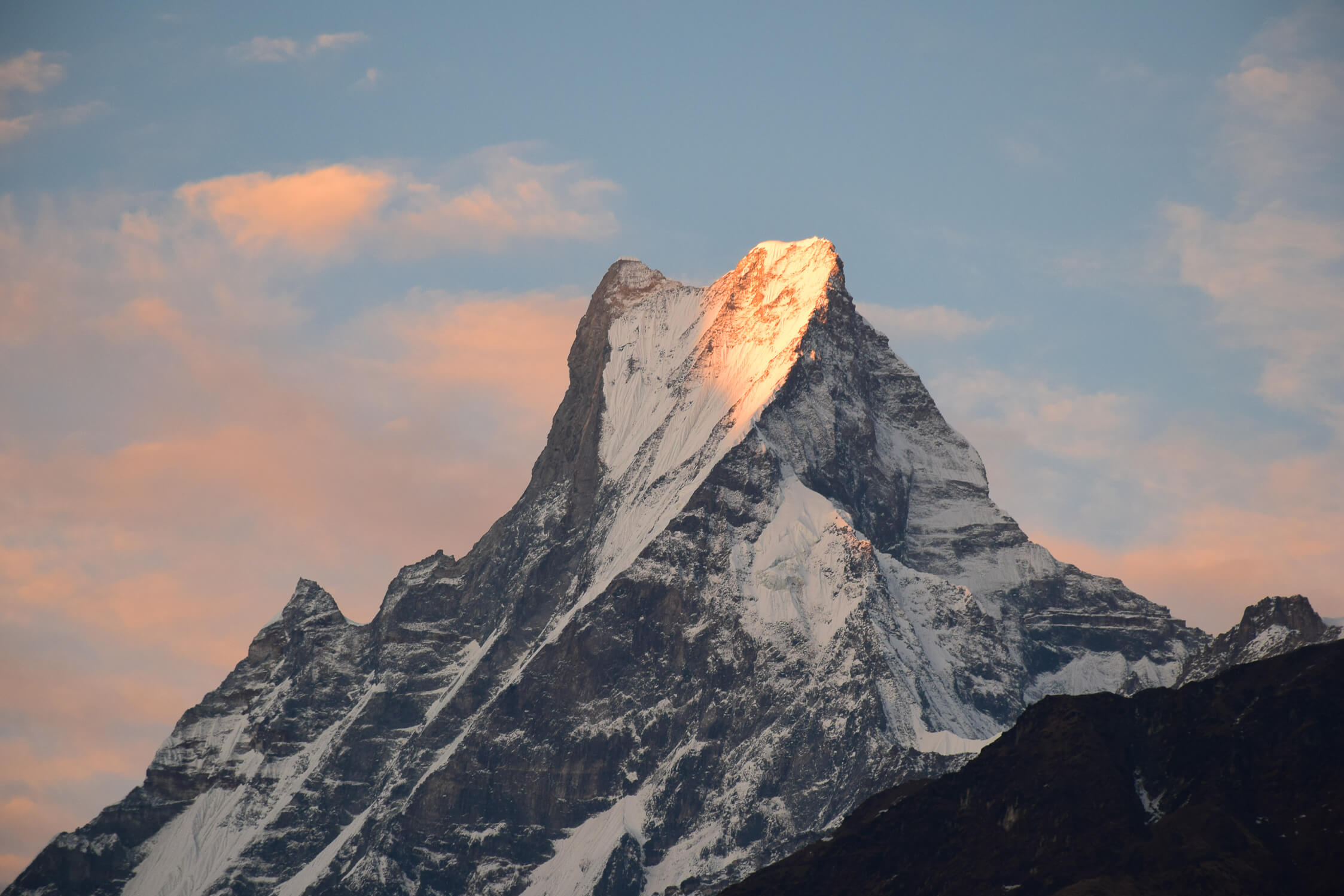
Pôr do sol em Macchapuchhre. Eu juro que é uma foto nossa, e não um papel de parede de computador.
Nossa caminhada foi absolutamente incrível. Pegamos um guia local (Ratna) e um porter (Chaite) para carregar nossas malas, decisão que valorizamos demais logo nos primeiros dias - ter alguém para dar informações sobre a região, sobre a cultura local e para reservar nossa hospedagem fez a nossa experiência ser muito mais agradável e fácil.
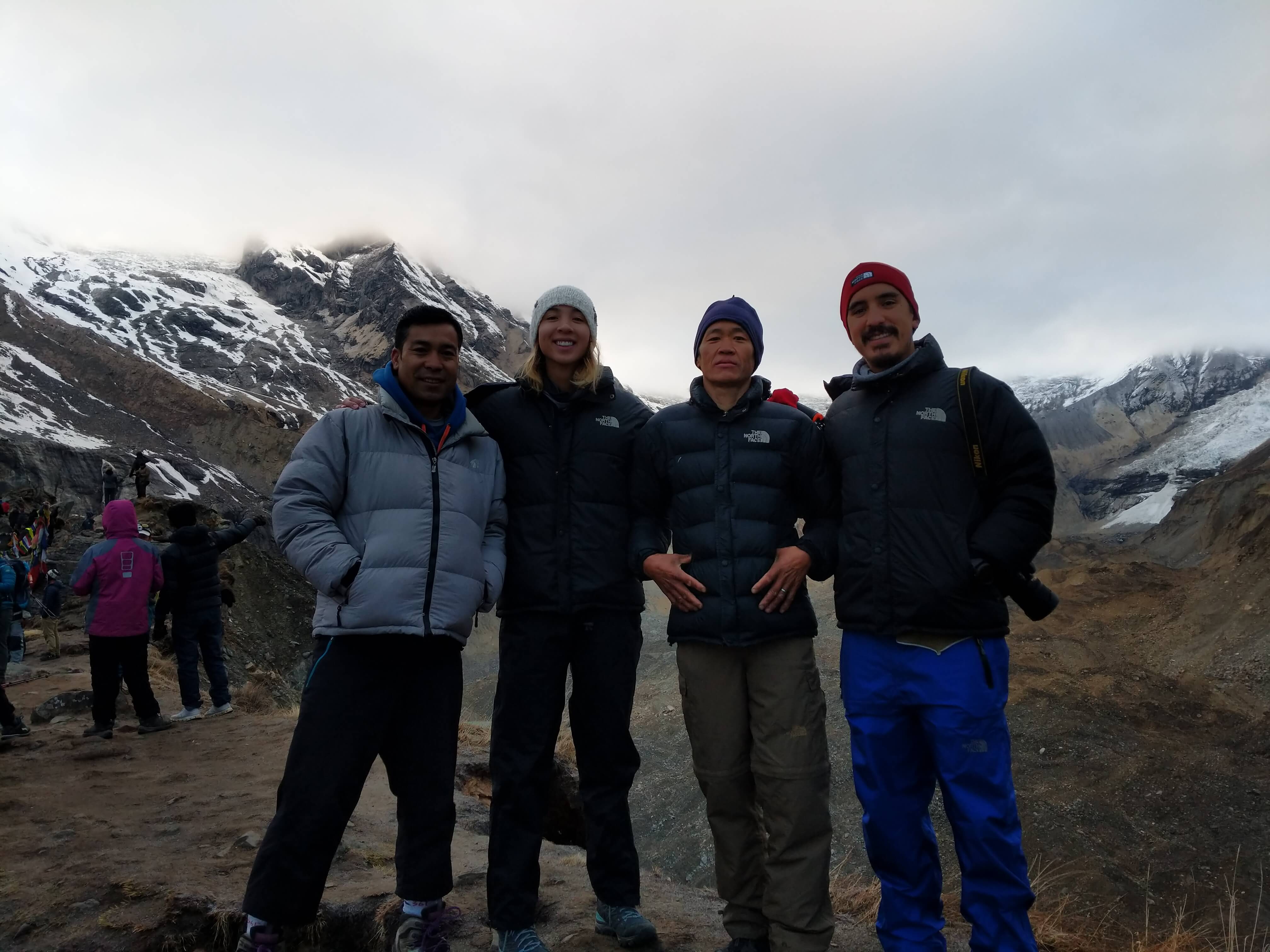
A nossa gangue: Ratna (nosso guia), Alex, Chaite (nosso porter) e eu.
A maior surpresa foi a infraestrutura disponível no caminho: são vilas pequenas e remotas ao longo de todo o caminho até o base camp, e todas as vilas são mais ou menos parecidas - algumas cabanas (ou “lodges”) extremamente confortáveis, com comida caseira de qualidade e banho quente (aleluia!), umas lojinhas para comprar o básico, e normalmente umas fazendas com plantações de milho, trigo, e verduras.
Foram 9 dias na montanha, onde tivemos praticamente uma rotina - acordávamos por volta das 6am, tomávamos café da manhã, e começávamos a caminhada. Fizemos um total de 101km nesses 9 dias, e andávamos em média 4 a 5h por dia. Almoço era pelo caminho ou então no destino final do dia. Depois de um banho quente e um chá, tínhamos tempo de tirar uma siesta e explorar o vilarejo, antes de jantar e dormir cedo para começar tudo de novo. Pegamos chuva, calor, neve e muita subida e descida pelo caminho. O mais fascinante de tudo foi ver a vida das pessoas na montanha: fazendas, plantações, hotéis para os turistas, lojinhas de conveniência e souvenir. Tudo que está a venda lá ou foi carregado por burros ou nas costas de pessoas, então os preços refletem o esforço de trazer a mercadoria, e o desperdício de comida é algo não tolerado por lá, por razões óbvias.

Burros carregando comida e mantimentos para as vilas
Duas das minhas descobertas preferidas lá foram o dal bhat (prato típico do Nepal, feito de arroz, sopa de lentilha, um curry ou vegetais, e pickles - o interessante é que se você pedir esse prato no restaurante, você tem direito a refill de tudo, o quanto você quiser e aguentar comer), e o rakshi (o equivalente ao vinho do Nepal, um destilado feito de arroz ou trigo, que lembra bastante sake. Forte, porém suave de beber).
No final das contas, essa é uma caminhada extremamente agradável. Difícil, sim, mas acredito que qualquer pessoa com o mínimo de preparo físico consegue fazer. Vimos crianças de 3 anos e idosos de 80 durante a caminhada, então ela é realmente acessível. E o fato de ter acampamentos por todo o caminho proporciona o conforto e a garantia de ter um banho quente, comida caseira e uma cama para dormir no final do dia.
Abaixo tem o detalhe de quanto andamos por dia, onde começamos e terminamos, quantos km’s e - para os nerds de plantão tipo eu - o link para as atividades no Strava, porque obviamente eu coloquei tudo no meu Garmin. Também tem as fotos que tiramos lá, espero que gostem.



